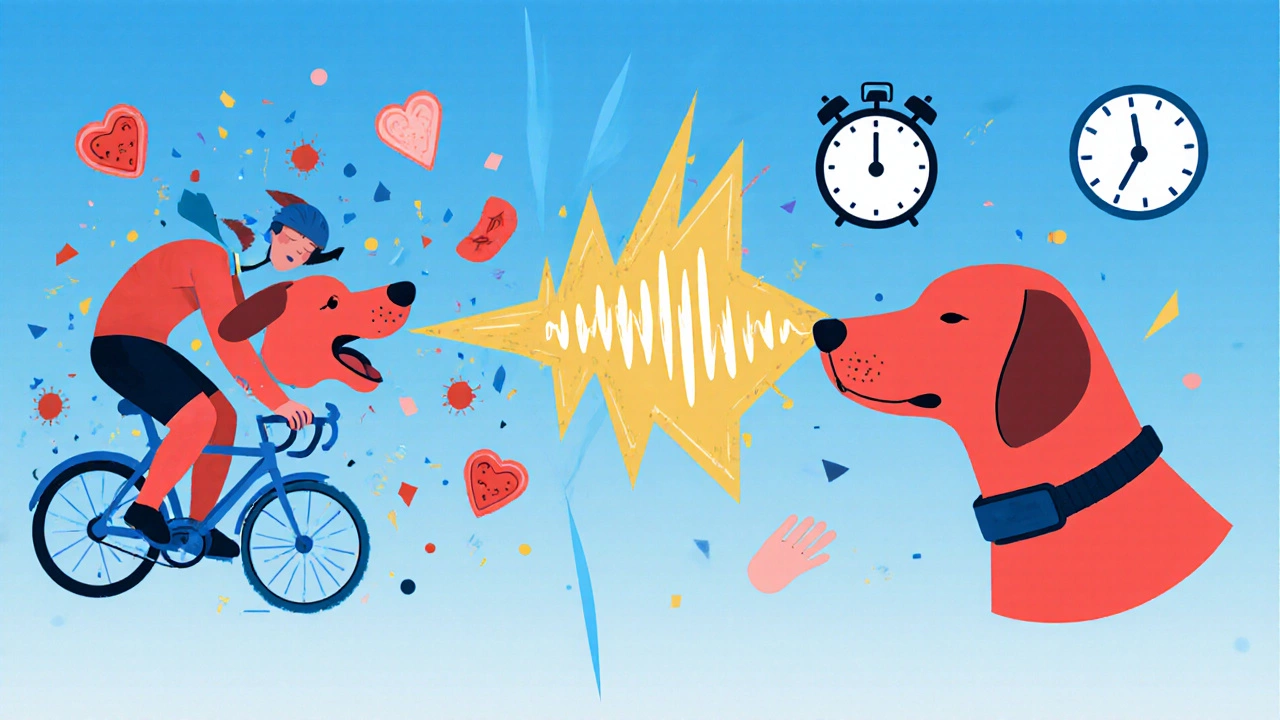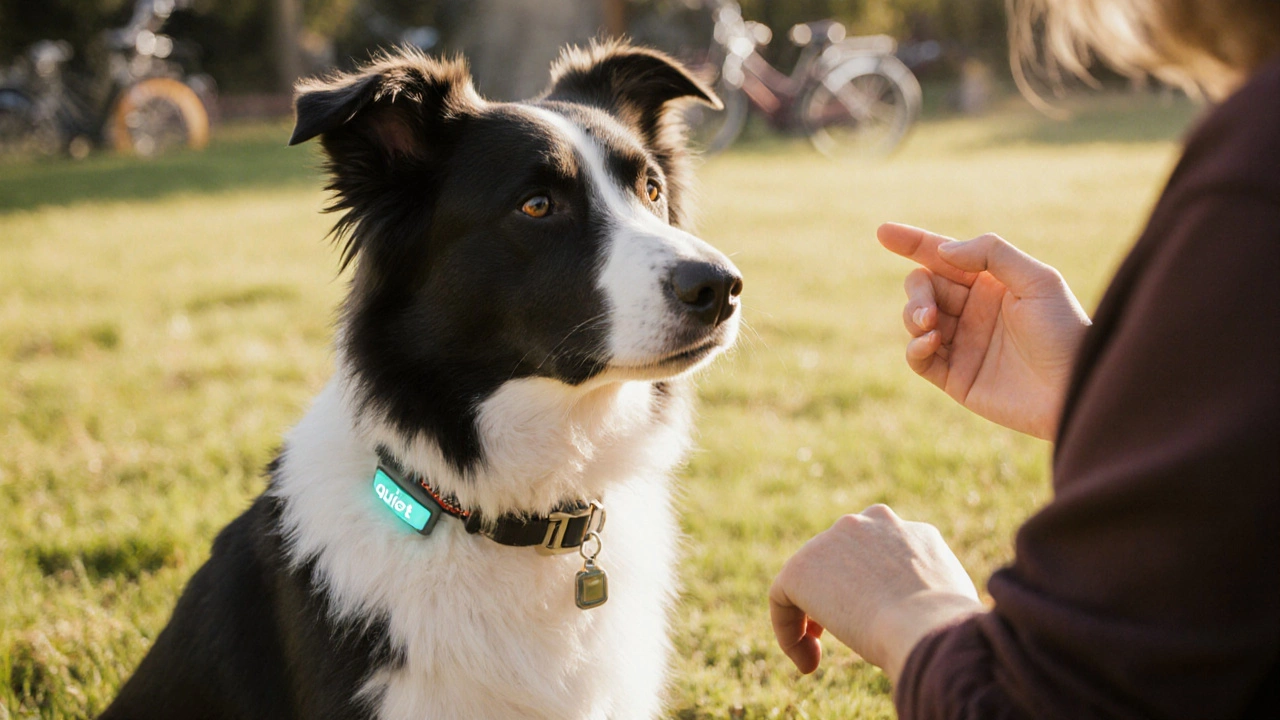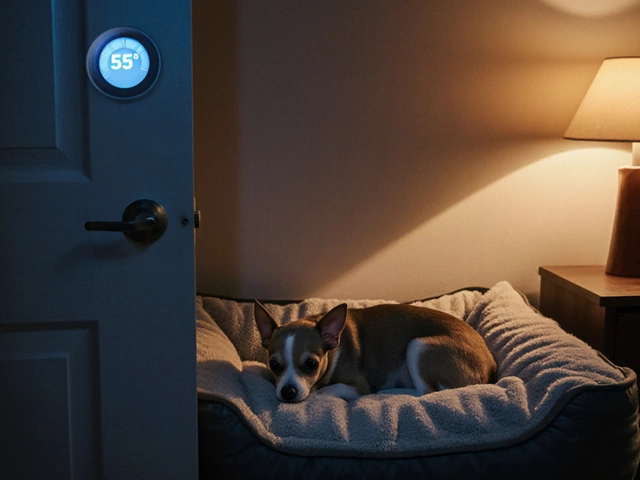Ever seen a dog owner reach for a vibrating collar and wondered if it’s just a gimmick-or if it actually works? You’re not alone. These collars have popped up everywhere: online stores, pet supply shops, even vet clinics. But the truth? Most people don’t know how they really function, or whether they’re safe, effective, or just another tool that looks good on paper.
What even is a vibrating dog collar?
A vibrating dog collar is a training device that delivers a gentle buzz to your dog’s neck-not a shock, not a sound, not a spray. It’s designed to get your dog’s attention without pain. The vibration is usually adjustable, from a soft pulse to a stronger rumble, and it’s meant to replace older, harsher methods like electric shocks or loud sonic tones.
These collars are often used for three things: stopping excessive barking, getting a dog to come when called (especially in distracting environments), and redirecting unwanted behavior like chasing squirrels or lunging at other dogs. The idea is simple: when the dog does something you don’t like, the collar vibrates. Over time, the dog learns to associate the buzz with the need to stop or change behavior.
Do they actually work?
Yes-but only if you use them right. And that’s where most people fail.
One 2023 study from the University of Bristol’s Animal Behaviour Lab tracked 87 dogs using vibrating collars for bark control over 6 weeks. Results showed a 68% reduction in excessive barking in dogs whose owners followed the training protocol correctly. But here’s the catch: in the group where owners just put the collar on and hoped for the best? Zero improvement.
It’s not the collar that works. It’s the training behind it.
Think of the vibration like a tap on the shoulder. If you’ve ever been in a noisy room and someone tapped you to get your attention, you turned around, right? That’s the goal. The collar doesn’t punish. It signals. But if you never teach your dog what the vibration means, it’s just noise.
How to use a vibrating collar the right way
Here’s the step-by-step method that actually works:
- Start with the lowest vibration setting. Most dogs react to the lightest buzz-no need to crank it up.
- Pair the vibration with a clear cue. Say “quiet” when your dog barks, then activate the collar. Do this every time.
- As soon as your dog stops barking, stop the vibration and give a treat or praise. Timing matters: the reward has to come within 2 seconds.
- After a few days, try the cue without the collar. If your dog responds to just the word “quiet,” you’re making progress.
- Only use the collar in situations you’re actively training for. Don’t leave it on all day.
One owner in Bristol, Sarah M., used this method with her border collie, Finn, who used to bark at passing cyclists. After two weeks of consistent pairing-vibration + “quiet” + treat-Finn now looks at her instead of barking. No collar needed anymore.

When vibrating collars don’t work-and why
They fail in three common cases:
- Used as punishment: If you only buzz your dog when they’re already doing something wrong-with no clear cue or reward-you’re just confusing them. Dogs don’t connect the buzz to the behavior if there’s no pattern.
- Used on anxious or fearful dogs: A vibration can feel like a surprise attack to a dog already on edge. One rescue center in Cornwall reported increased stress in 40% of nervous dogs using vibrating collars without prior desensitization.
- Used as a substitute for training: If you think the collar will do all the work, you’re wrong. Training requires consistency, timing, and positive reinforcement. The collar is a tool, not a magic button.
Also, not all collars are built the same. Cheap ones from Amazon or eBay often have inconsistent vibrations-sometimes too weak, sometimes too strong. Look for brands with adjustable settings, waterproofing, and good battery life. Brands like SportDOG, Dogtra, and PetSafe have been tested in independent labs and consistently deliver reliable output.
Are vibrating collars better than shock collars?
Yes. And the science backs it up.
A 2024 review of 12 peer-reviewed studies comparing vibration, shock, and sound-based collars found that vibration collars produced the lowest stress levels in dogs, measured by cortisol levels and body language. Dogs using shock collars showed more panting, lip licking, and avoidance behaviors-signs of fear. Those using vibration showed curiosity or indifference.
Shock collars work by pain. Vibration collars work by attention. One forces compliance. The other builds understanding.
Many countries in Europe have banned shock collars. The UK doesn’t have a full ban yet, but the RSPCA and the Kennel Club both recommend vibration collars as a humane alternative. If you’re looking for a tool that’s effective and ethical, vibration is the clear winner.
Who should avoid vibrating collars?
Not every dog is a good fit.
- Deaf dogs: If your dog can’t hear, they may not notice the vibration unless it’s strong enough to feel through their body. Even then, they might not understand why it’s happening. For deaf dogs, hand signals and visual cues are far more effective.
- Senior dogs with arthritis: A vibrating collar on a stiff neck can cause discomfort. The added pressure and buzz might irritate joints.
- Dogs with skin sensitivities: Some collars cause redness or irritation if worn too long. Always check the skin under the collar daily.
If your dog has a history of anxiety, trauma, or reactivity, talk to a certified dog trainer before using any collar. Sometimes, positive reinforcement training with treats and play is safer and more effective.

Alternatives to vibrating collars
There are other tools that work just as well-or better-depending on your dog:
- Clicker training: Uses a small device that makes a distinct “click” sound to mark good behavior, followed by a treat. Highly effective for teaching new commands.
- Head halters: Like a gentle muzzle that guides your dog’s head. Great for leash pulling.
- Remote treat dispensers: You can trigger a treat from across the yard when your dog comes back. Works wonders for recall training.
- Professional positive reinforcement trainers: Sometimes, the best tool is expert guidance.
Many trainers in the UK now use a mix of clickers, treats, and hand signals-and rarely use collars at all. If you’re willing to invest time, you might not need a collar at all.
Final verdict: Do vibrating dog collars work?
They can. But only if you treat them like a communication tool, not a punishment device.
Used correctly-with patience, consistency, and positive reinforcement-they help dogs understand what’s expected. Used wrong, they create confusion or fear.
If you’re considering one, start with a reputable brand, set it to the lowest setting, and pair every buzz with a clear cue and reward. Don’t just buy it and hope. Train with it.
And remember: the best training tool isn’t a collar. It’s your attention. Your timing. Your willingness to learn your dog’s language.
Are vibrating dog collars cruel?
No, not when used correctly. Vibrating collars don’t cause pain-they deliver a gentle buzz to get attention. Unlike shock collars, they don’t burn or sting. The RSPCA and Kennel Club in the UK support them as a humane alternative to electric training tools. The key is how you use them: pairing the vibration with positive reinforcement, never as punishment.
Can vibrating collars make my dog more anxious?
Possibly-if you use them incorrectly. If the vibration feels sudden, unpredictable, or is paired with yelling or punishment, your dog may become fearful. Dogs with existing anxiety, trauma, or noise sensitivity should avoid vibrating collars unless introduced slowly under the guidance of a professional trainer. Always monitor your dog’s body language: tail tucking, ears back, or hiding are signs to stop.
How long should my dog wear a vibrating collar?
Only during training sessions-usually 15 to 30 minutes at a time. Never leave it on for more than 4 hours total per day. Remove it at night and during playtime. Constant wear can cause skin irritation or make your dog tune out the vibration. The goal is to teach your dog the cue, not to rely on the collar forever.
Can I use a vibrating collar for a puppy?
Not until they’re at least 6 months old. Puppies are still learning how to process sensory input. Their skin is sensitive, and their attention spans are short. Focus on positive reinforcement, play, and basic commands first. If you need help with puppy barking or pulling, use a harness and treats instead.
What’s the best vibrating collar brand?
Look for SportDOG, Dogtra, or PetSafe. These brands offer adjustable vibration levels, waterproof designs, long battery life, and reliable remote control. Avoid no-name brands on Amazon-many have inconsistent output or poor build quality. Read reviews from dog trainers, not just customers. A good collar costs between £50 and £100, but it’s an investment in your dog’s training, not a cheap gadget.
What to do next
If you’re thinking about trying a vibrating collar, start small. Borrow one from a friend or a local trainer before buying. Watch how your dog reacts. Practice the cue-and-reward method for a week before even turning it on.
And if you’re not sure? Talk to a certified dog trainer. Many offer free consultations. You might discover that a few sessions of positive reinforcement training do more than any collar ever could.







